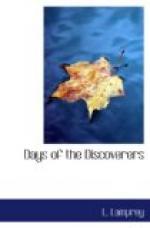No sign had been seen of Norumbega. Presently the keen expectant eye of Cartier caught sight of something which went far to shake his faith in that romantic citadel. It was a bold headland on the right, which would certainly have been chosen by any civilized king in Europe as a site for a fortress. Those mighty cliffs would almost make other defenses needless. Yet the heights were occupied by nothing more than a wooden village, which the interpreters called Stadacona, saying that their chief, Daghnacona, was its ruler. Shouts arose from the water’s edge as some one among the excited Indians recognized on the deck of a great winged canoe their own lost countrymen. The interpreters answered with joyous whoops. A dozen canoes came paddling out, filled with young warriors, and a rapid interchange of guttural Indian talk went on between Pierre and Kadoc and their kinfolk. The enthusiasm rose to a still higher pitch when strings of beads of all colors were handed down to the Indians in the canoes, and presently Daghnacona himself appeared to welcome the white men to his country, with dignified Indian eloquence and an escort of twelve canoes. This was clearly a good place to stop and refit the ships. Cartier took his fleet into a little river not far away, and prepared to learn all he could of the country before going on.
The information he got from Daghnacona was not encouraging. This was not, it appeared, the chief town of the country. That was many miles up the river, and was called Hochelaga. It would not be safe for the white men to go there. Their ships might be caught between ice-floes, and the falling snow would blind and bewilder them. Cartier glanced at the blue autumn sky and smiled. No one is quicker than an Indian to read faces. Daghnacona saw that the white chief intended to go, all the same.
Cartier decided to leave the larger ships where they were, and proceed up the great river to Hochelaga with a forty-ton pinnace, two boats, and about fifty men. Early in the morning, before he was quite ready to start, a canoe came down stream, in which were three weird figures resembling the devils in a medieval miracle-play. Their faces were jet black, they were clothed in hairy skins, and on their heads were great horns. As they passed the ships they kept up a monotonous and appalling chant, and as their canoe touched the beach all three fell upon their faces. Indians, rushing out of the woods, dragged them into a thicket, and a great hubbub followed, not a word of which was understood by the white men, for the Indian interpreters were there with the rest. Presently the interpreters appeared on the beach yelling with fright.
“Pierre! Kadoc!” the annoyed commander called from his quarter-deck, “what is all this hullabaloo about?”
“News!” gasped Pierre. “News from Canghyenye! He says white men not come to Hochelaga!” And Kadoc chimed in eagerly, “Not go! Not go!”
“Coudouagny?” Cartier repeated to Maclou, completely mystified. “Who can that be?”




